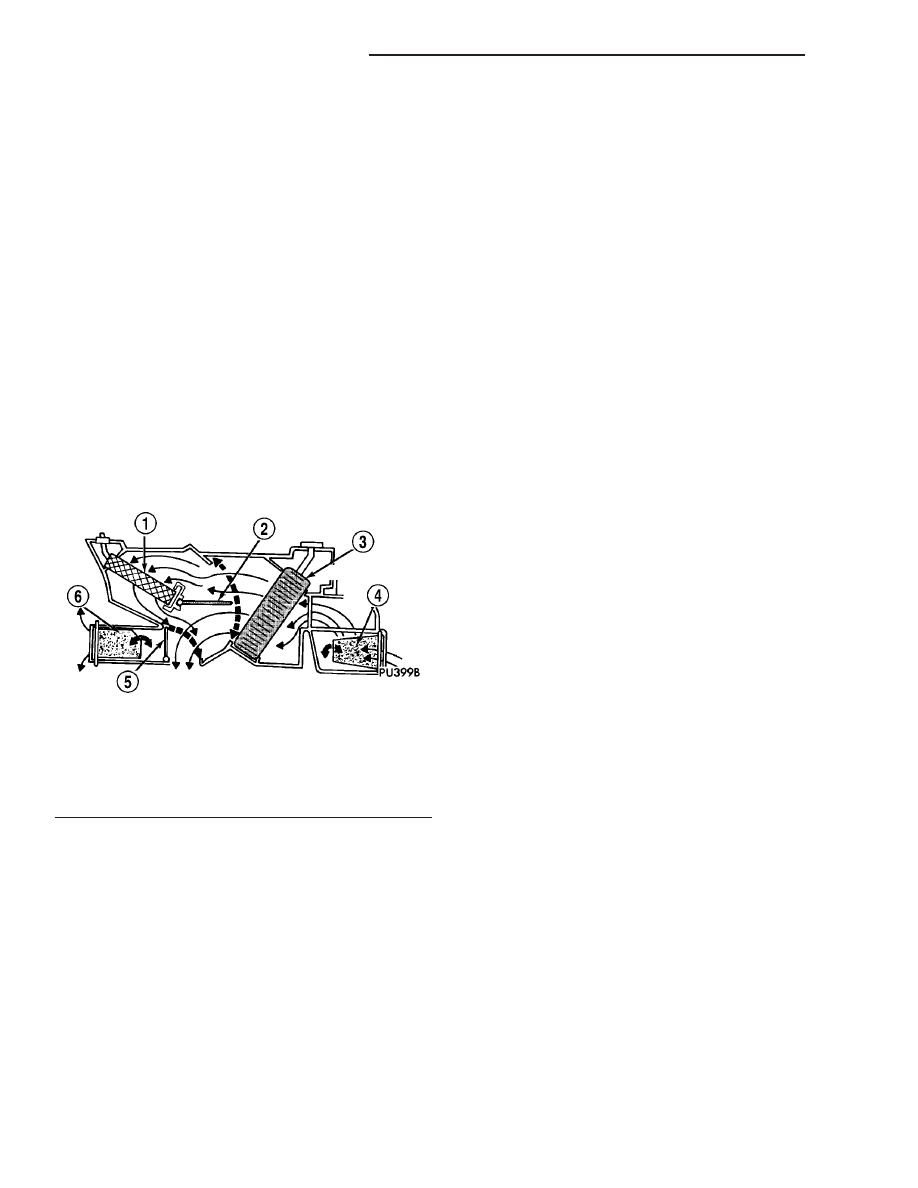Jeep Wrangler TJ. Manual - part 584

each outboard end of the instrument panel, above the
panel outlets.
• Panel Outlets - There are four panel outlets in
the instrument panel, one located near each outboard
end of the instrument panel facing the rear of the
vehicle and two located near the top of the instru-
ment panel center bezel.
• Front Floor Outlets - There are two front floor
outlets, one located above each side of the floor panel
center tunnel near the dash panel.
OPERATION
Both the single zone manual temperature control
(MTC) heating-A/C system and the heater-only sys-
tem are blend-air type systems. In a blend-air heat-
ing-A/C system (Fig. 2), a blend-air door controls the
amount of conditioned air that is allowed to flow
through, or around, the heater core. The temperature
control determines the discharge air temperature by
operating the blend door actuator, which move the
blend-air door. This design allows almost immediate
control of output air temperatures.
The heating and A/C systems pulls outside (ambi-
ent) air through the cowl opening at the base of the
windshield, then into the air inlet housing above the
heating, ventilation and air conditioning (HVAC)
housing. On models equipped with A/C, the air
passes through the A/C evaporator. Air flow can be
directed either through or around the heater core.
This is done by adjusting the blend door with the
temperature control knob on the A/C-heater control
in the instrument panel. The air flow can then be
directed from the panel, floor and defrost outlets in
various combinations using the mode control located
on the A/C-heater control. Air flow velocity can be
adjusted with the blower fan speed control located on
the A/C-heater control.
On models equipped with A/C, the outside air
intake can be shut off by selecting the Recirculation
Mode. This will operate a vacuum actuated recircu-
lating-air door that closes off the fresh air intake and
recirculates the air that is already inside the vehicle.
The A/C compressor can be engaged by turning the
mode control clockwise from the Off position. It can
also be engaged by placing the mode control in the
mix to defrost positions. This will remove heat and
humidity from the air before it is directed through or
around the heater core. The mode control on the A/C-
heater control is used to also direct the conditioned
air to the selected system outlets. The mode control
uses engine vacuum to control the mode-air doors.
The defroster outlet receives airflow from the
HVAC housing through the molded plastic defroster
duct, which is connected to the HVAC housing
defroster outlet. The airflow from the defroster outlet
is directed by fixed vanes in the defroster grille and
cannot be adjusted.
The side window demisters receive airflow from the
HVAC housing through the molded plastic defroster
duct, two molded plastic demister ducts and two
molded plastic demister outlets. The airflow from the
side window demister outlets is directed by fixed
vanes in the demister grilles and cannot be adjusted.
The demisters direct air from the HVAC housing
through the outlets located on the top corners of the
instrument panel. The demisters operate when the
mode control is positioned in the floor-defrost and
defrost-only settings. Some air may be noticeable
from the demister outlets when the mode control is
in the bi-level to floor positions.
The four instrument panel outlets receive airflow
from the HVAC housing through a single molded
plastic instrument panel duct. The single instrument
panel duct directs airflow to all of the instrument
panel outlets. Each of these outlets can be individu-
ally adjusted to direct the flow of air.
The floor outlets receive airflow from the HVAC
housing through the floor distribution duct. The front
floor outlets are integral to the molded plastic floor
distribution duct, which is secured to the bottom of
the HVAC housing. The floor outlets cannot be
adjusted.
Fig. 2 Typical Blend-Air HVAC System
1 - HEATER CORE
2 - BLEND-AIR DOOR
3 - A/C EVAPORATOR
4 - RECIRCULATION-AIR DOOR
5 - FLOOR MODE-AIR DOOR
6 - PANEL/DEFROST MODE-AIR DOOR
24 - 2
HEATING & AIR CONDITIONING
TJ
HEATING & AIR CONDITIONING (Continued)